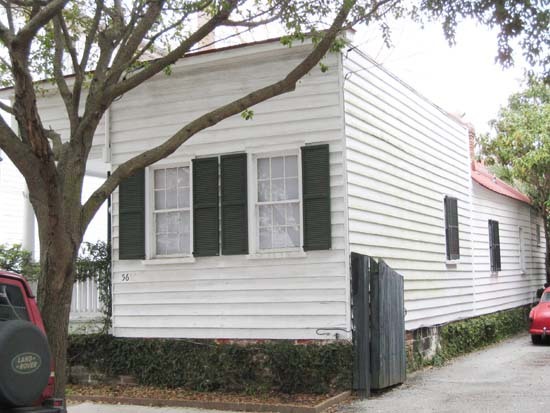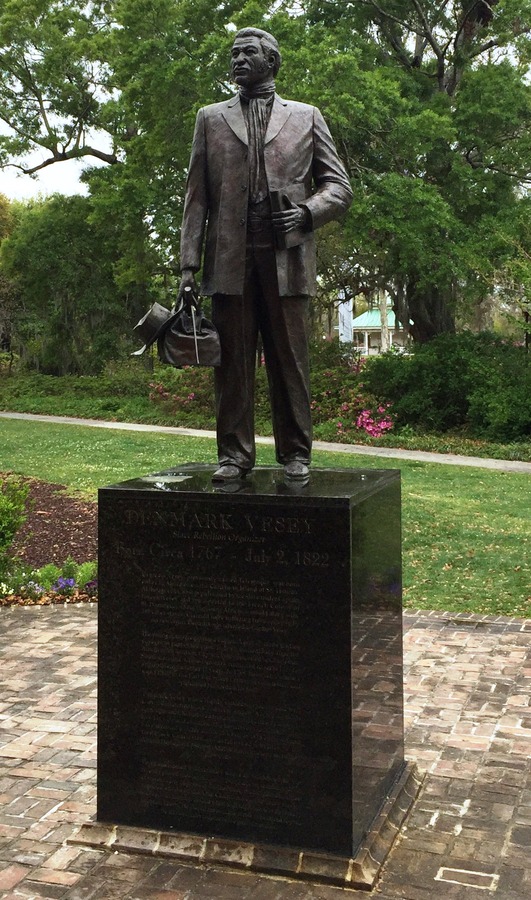The Denmark Vesey House, 56 Bull Street

The Denmark Vesey house, located at 56 Bull street, is listed on the National Register of Historic Places and even features a physical marker that states the historic value of the site.
The Denmark Vesey house, located at 56 Bull street, is listed on the National Register of Historic Places and even features a physical marker that states the historic value of the site. The designation of this site enables the city of Charleston to commemorate Denmark Vesey on the city’s historical landscape. However, the home that is currently standing and marked as Vesey’s house is actually not his former home. Vesey’s original home is no longer extant, and this property is a building near to where Vesey lived. Nevertheless, it was in a home nearby that Denmark Vesey, a free man and formerly enslaved person, planned to incite a large-scale uprising of Black Charlestonians (both free and enslaved).
Vesey had been previously enslaved in Haiti before being brought to Charleston by his owner during the British evacuation of the island in 1783. About sixteen years later, in 1799, Vesey participated in a lottery in the city and, after winning a hefty sum of $1,500, he purchased his freedom (note that in 1799 about $100 had around the same purchasing power as $2,103.07 in 2020, making his winnings equivalent to $31,546.05). Due to the successful revolt of enslaved persons in Haiti, many white Southerners feared the same in Charleston, and, in Denmark Vesey, they found their fears embodied (whether it be truly or not).
After purchasing his freedom, Vesey became a prominent member of the Black community in Charleston; he was able to read and write, and worked as a carpenter in the city. He held a leadership role in the African Methodist-Episcopal Church, which was opened in 1816, which would suffer major suppression by white authorities in Charleston. The church was eventually forced to close its doors by city authorities, and this was seen (alongside the continued enslavement of his children despite his status as a free man) as sufficient impetus for Vesey to begin planning his mass revolt to free the enslaved peoples of Charleston.
The plans for rebellion came about in 1822, apparently modeled on the successful 1791 slave revolution in Haiti. According to testimony at the trial, the plan called for the Black residents of Charleston to rise up, kill their masters, and take over the city. Once the city was successfully liberated, instead of attempting to remain in control and combat the white retaliation that would surely come from the rest of the United States, the newly freed Black men and women would then steal ships from the harbor in order to make an escape to Haiti.
The plan was betrayed, however, by two slaves who participated in the planning stage. The men leaked details of the plot to their masters before the initial phases of the plan could begin, and those masters quickly passed the information on to city authorities. Charleston police soon organized and mobilized a mass arrest that included Vesey and about 131 other men. They were charged with conspiracy. Of those arrested, 67 were convicted, and 35 were sentenced to death and hanged, including Denmark Vesey.
While Vesey would be seen as an embodiment of fear and evil by pro-slavery whites, he would become a hero and be viewed as a martyr for freedom by abolitionists, adding fuel to the fire of anti-slavery activity in the United States. Such famous individuals that were inspired by Denmark Vesey included Frederick Douglass, who used Vesey’s story as a call-to-arms to other Black Americans to join the fight against the Confederacy, and Colonel Shaw, the commanding officer of the 54th Massachusetts Infantry Regiment, the first all-Black infantry in the Northeast.
According to the site’s entry in the National Register of Historic Places, “research since the time of nomination has shown that 56 Bull Street was not Vesey’s house. There is no concrete evidence to support that Vesey ever lived at this address, or that this house was even standing ca. 1820.” Despite this lack of historical integrity, the site in question was designated as a National Historic Landmark in May of 1976. While the site itself may lack historical accuracy and integrity, the story of Denmark Vesey, and the legacy he left behind, lives on at this site.
The immediate consequences of Vesey’s apparent plot and his subsequent execution would come as the city of Charleston and the state of South Carolina began to crack down upon what little freedoms existed for Black residents of the state. In the hopes that they could oppress the enslaved (and formerly enslaved) population enough to prevent another Vesey from rising to prominence, the white ruling class of South Carolina spent the decades after 1822 passing laws and ordinances designed to constrain Black lives and freedom of movement. While this may have appeared an effective reactionary tactic at the time, Vesey had already become a martyr to those agitating for freedom, and the increased oppression of the white upper class only helped to add fuel to the fire.
When the American Civil War began it would be Denmark Vesey’s name and memory that would be used by famed abolitionists such as Frederick Douglass to call African Americans across the United States to arms, to join the Union and fight back against the Confederacy. Years later, into the Civil Rights movements of the 1960s, Vesey would again be called upon as a martyr and as inspiration during strikes and protests in Charleston, such as the Hospital Workers’ Strike in 1969. Vesey’s martyrdom, even long after his execution by white authorities, would remain a potent symbol of African American resistance to the oppression of slavery and racial caste systems. His influence continues to affect Charleston to this day, even in arguably more “quiet” ways. The Citadel, the military academy in the city, traces its origins to the response to Vesey’s plot, originally established as a weapons cache and defensive installation in case of future attempts at African American militancy.
The house at 56 Bull Street was designated as Vesey’s residence for the National Historic Landmark nomination through the efforts of the Afro-American Bicentennial Corporation, a non-profit that pushed for more racially inclusive histories to be told throughout the United States. The Bull Street house was not their first choice to represent the history and legacy of Denmark Vesey, yet other sites they sought nomination for (such as the A.M.E. Church on Calhoun Street) ran into problems of changed locations and non-extant structures that disqualified them from National Register considerations. While considerable effort and research went into the selection of 56 Bull Street as Vesey’s home, the information available on where Vesey had actually lived was limited. A major obstacle in this research was Charleston’s historical street numbering system, which was often chaotic and ever shifting, making it surprisingly difficult to match up historical and modern street addresses. After an arduous process of historical research, the potential sites were narrowed enough to satisfy the National Park Service, designating the house as a National Historic Landmark in 1976.
There is now a statue to Denmark Vesey in Charleston’s Hampton Park, ostensibly a more accurate physical memorial of the man and his legacy than the house on Bull Street, though even this statue drew the ire of some white residents who found a remembrance of Vesey’s militancy to be inappropriate. The statue, however, is only a singular, more concentrated symbol of Vesey’s story and the consequences of his legacy. In many ways, even subconsciously, his actions and the actions taken against him, can be felt across the city to this day.
Images

